What are additive in concrete - detailed guidance on the use of chemicals
Table of contents
-
1 What is concrete
- 1.1 Preparation of concrete mortar with additives
- 1.2 Which affects the quality of concrete
-
2 Varieties of concrete admixtures
- 2.1 plasticizer
- 2.2 curing accelerators
- 2.3 retarders hardening
- 2.4 Winter additives
- 2.5 Air-entraining additives, and blowing
- 2.6 additives
- 3 Cost additives for concrete
- 4 conclusion
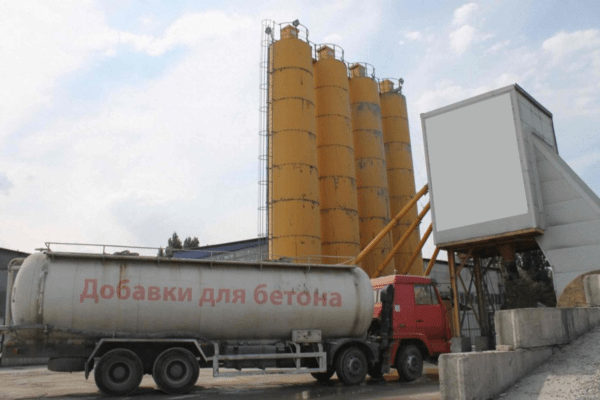
Additives are used not only in private construction, but also in the industrial production of concrete solutions.
You plan to perform concrete works, but do not know how to make a quality solution? I'll tell you about a variety of concrete admixtures for frost resistance and improve its performance. And as a bonus offer more concrete preparation technology.
What is concrete
Concrete - an artificial stone material, which is formed by the seal and hardening of the grout. Concrete solution consists of coarse aggregate, fine aggregate, binder and water. It includes the following components:
- Cement - a binder that hardens in contact with water, forming an artificial cement stone.
- Cement binds in solution and binds the aggregate particles together, so on its quantity and quality depends-grade concrete strength;
- For the manufacture of ready-mixed concrete construction used cement brand M200-M500.

Cement is better not to buy in bulk and packed in bags, because it is more qualitative.
- crushed stone - coarse aggregate, and the basis of any concrete product. During the operation he takes the brunt of the load in compression.
- The most durable and is considered to be qualitative crushed granite chippings from 10 to 150 mm;
- The maximum size of crushed rock particles in the solution must be three times less than the minimum thickness of the concrete product;
- For example, for pouring concrete screed 80 mm, stone chips should have a particle size of 15-25 mm.
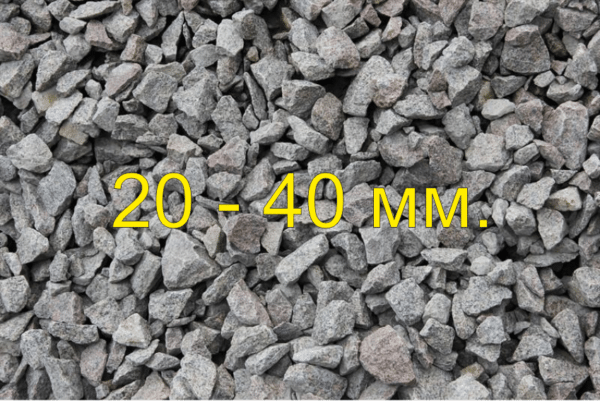
The designation of gravel fraction on the photo Set the minimum and maximum size of its particles.
- Sand - fine aggregate, which is enveloped by particles of cement, and with it fills the voids between the gravel particles.
- Sand may be small or large, most importantly that it had no clay since it significantly impairs the quality of the concrete;
- For this reason, for the preparation of the solution best suited washed river sand.
- Water - required for the formation of cement stone. During the chemical reaction of water with cement, the particles firmly bonded to each other:
- Such a reaction called hydration;
- Water should be clean and free acid salts and impurities, with 15-25 ° C temperature.
- modifying Adofoam - a set of special additives which impart certain properties of the concrete solution.

The stores sell a large variety of additives, and their right to choose, I'll discuss in this article.
Preparation of concrete mortar with additives
The concrete mix can be bought ready-made and can be made with your own hands. For the preparation of different grades of concrete, all the components are mixed with each other in a strict proportion to obtain a thick homogeneous mass:
| Illustration | Concrete Preparation Instructions |
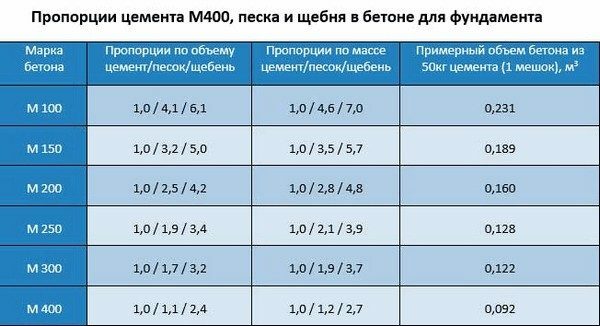 |
The use of concrete brand M100-M400:
|
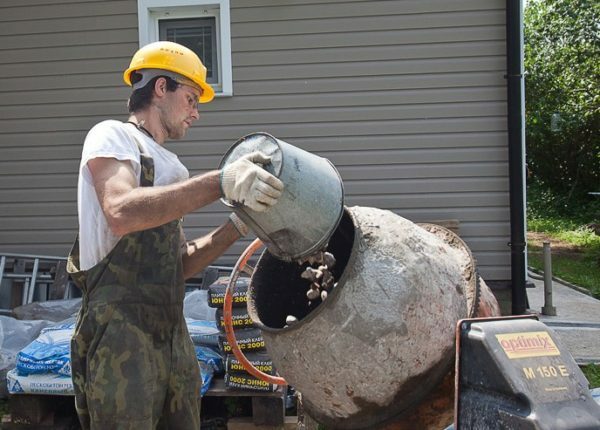 |
Download solution components:
|
 |
Introduction of additives:
After addition of all components, stirring the solution may be no more than 5 minutes. Otherwise it is stratified, and its quality is deteriorated. |
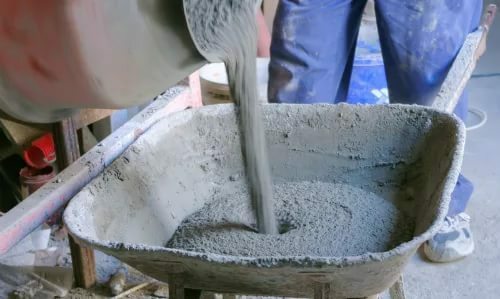 |
The use of concrete:
|
Branded concrete strength is indicated as "M" and a numerical value, e.g., M100, M200 and etc. The numeric value represents the maximum static load of 1 kg per cm². For example, for concrete grade M150 maximum permissible compressive load of 150 kg / cm².
Which affects the quality of concrete
In some cases, the actual strength of concrete products, cement stone, even after maturation may be lower than the declared branded concrete hardness. This may be several reasons:
- brand of cement:
- The higher the grade of cement used, the better and more durable concrete solution obtained;
- Another advantage of the high marks - it saves cement. For example, to prepare the same grade of concrete, cement M400 required two times less than the M200.
The table shows the proportions of components and the water-cement ratio for the various grades of concrete.
- Water-cement ratio (W / C):
- This indicator is characterized by the ratio of the amount of water to the quantity of cement in the concrete solution. For example, if used for the preparation of 2 parts cement and 1 part water, the W / C of the solution is 0.5;
- For the hydration process is sufficient ratio of 0.2, but such a solution will very thick;
- To increase the plasticity and fluidity of a solution, a W / C is usually increased to 0.3-0.5;
- At the same time, excess water significantly reduces the strength of the concrete, so I advise you not to increase the index of W / C of more than 0.8. That is, in the bucket 1 can be filled with cement not exceeding 0.8 water bucket.
- viscosity of the solution:
- To a solution of the concrete filled the formwork form without the formation of voids and air pockets, it should be flowable and pliable;
- To increase the plasticity of the concrete mix, the excess water in the solution can not be refilled;
- To make it more fluid, without the addition of water, plasticizers are used.

To determine the viscosity of the solution used special cone as a metal bucket without a bottom.
- Water penetration:
- Even the most severe grade of concrete have a honeycomb structure with open pores;
- Through the pores of the water slowly seeps through the concrete thickness;
- This leads to a reinforcement corrosion, leakage and destruction of the walls of basins forces frost heaving.
- Air cavity:
- The presence of voids, voids and air pockets reduces the density and strength of concrete branded products;
- When water freezes in the cavities, it expands to form micro-cracks in the concrete body;
- Under the influence of repeated cycles of freeze / thaw durability of concrete structures is gradually reduced.
- Ambient temperature:
- For normal operation, with a concrete solution ambient temperature should be below 0 ° C, but already at lower temperatures to + 5 ° C of its grasp markedly deteriorates;
- At sub-zero temperatures freezing water expands and breaks the bonds between the cement particles;
- Ice can not react with the cement, so the frozen solution is stopped and the hydration of the cement stone formation.
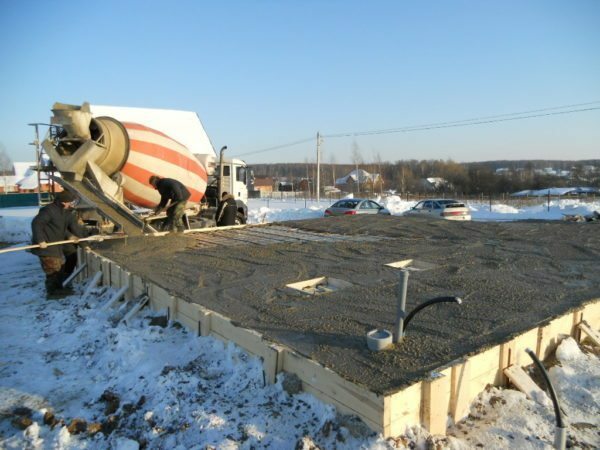
When concreting in the bitter cold work to be performed as quickly as possible, so that the water did not have time to freeze.
Varieties of concrete admixtures

The table shows the classification and main characteristics of the most popular additives to concrete.
plasticizer
Plasticizers are considered the most common additive, which is used in housing construction throughout the year. They are manufactured on the basis of liquid surfactants (surfactant) with the addition of auxiliary components.
The effect of plasticizers:
- Surfactants reduce the surface tension of water, and improve the wettability of dry solids;
- Water with the addition of a surfactant becomes slippery and slightly soapy to the touch, and thereby reduces the friction between the particles of coarse and fine aggregate;
- The solid solution components are enveloped with liquid soap, and easily slide relative to each other under its own weight downward and the air bubbles between them freely go upward;
- Thus, when concrete is poured dense homogeneous mass is obtained without voids, voids and air bubbles.
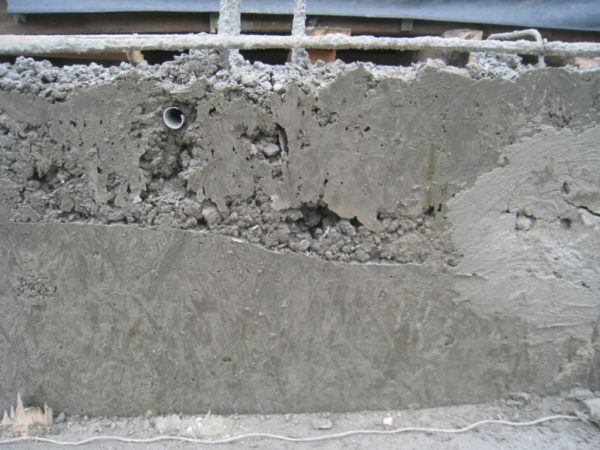
These concrete products are obtained in low mobility and plasticity of the solution.
Features of the application of plasticizers:
- Adding plasticizer allows to obtain a thick and dense concrete mix with good mobility, fluidity and workability;
- It is well flows into the narrow and deep space penetrates gustoarmirovannye design, he does not stick to walls forms and timbering, and after curing has a high resistance to frost and extremes temperature;
- To achieve normal consistency of the solution is required to add less water, thereby increasing the density and strength of concrete;
- By its action plasticizing agents are divided into two types:
- superplasticizers - reduce the amount of water to 10% without compromising the quality and mobility of the concrete mix;
- Giperplastifikatory - have the same properties, but reduce the amount of water in solution at 20% of the required volume;
- Due to the smaller amount of water may be added to a solution of minimal amount of binder, which allows more economical use of expensive cement.
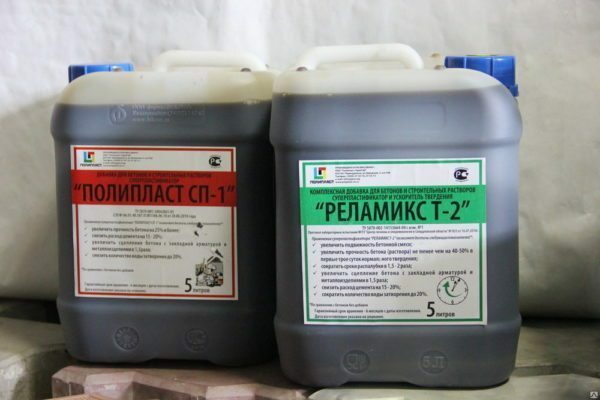
Plasticizer mixture often sold in combination with other additives.
If you do not have a plasticizer to improve the mobility of the concrete You can use any soap or dishwashing detergent. It needs to add water to the mixing solution, the rate of 1 to 2 cap finished concrete buckets.
curing accelerators
Under normal conditions, the setting time of concrete mortar can last from 6 to 12 hours, and the final ripening period can last from 7 to 28 days. In some cases, setting the time you need to increase or decrease.
For this purpose retarders or accelerators of hardening concrete. Such an additive is sold as a powder of sodium chloride or calcium chloride with various additives. Chlorides, its member, has a double effect on the hardening concrete:
- Fast setting. An aqueous solution of sodium chloride reacts with the cement, and accelerates the setting of cement paste;
- Low freezing temperatures. The saline solution has a freezing temperature well below 0 ° C, so the concrete with additives is not converted into a block of ice at low temperatures.
Scope:
- Boosters makes sense to use when pouring a new concrete batch only after the complete hardening of the previous layer of the solution;
- In residential construction this additive in concrete may be needed when casting basin bowls for installation reinforced the ceiling, in the manufacture of artistic moldings and other architectural details decoration;
- When concreting in a strong frost is important that the concrete is scored at least 50% of its strength to the water in the solution is completely frozen, otherwise the quality will be very low, and it is rapidly destroyed;
- In this case, the addition of chloride salts reduces the freezing point of water, and accelerates the hardening time of concrete, so it has time to collect the required strength.
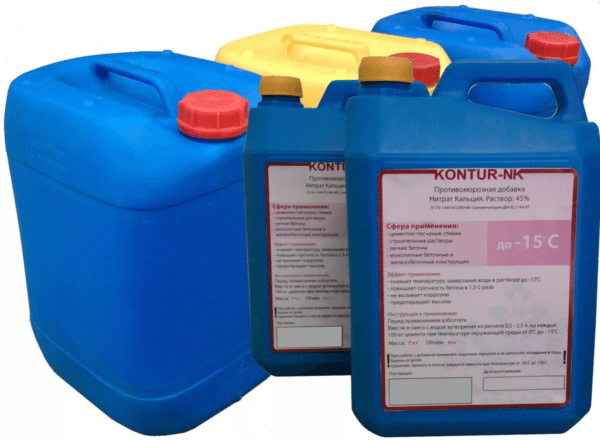
Salt Additives sold not only in powder form but also in the form of an aqueous solution.
Chloride salts when in contact with ferrous metals cause active corrosion. Therefore, such substances are not recommended for use in concrete products with a diameter of the reinforcing bars binding by less than 5 mm.
retarders hardening
Such an additive for concrete slows the hydration reaction and slows the setting of cement stone, concrete mix time prolonging viability. The slowing housing supplements are used infrequently, but in some cases without them can not do, such as:
- Long distance transport:
- If you need a concrete solution to transport over long distances, the delivery time, he may begin to fasten directly into the mixer, even if it is constantly agitated;
- To avoid this, the retarder is added to the solution.
- Continuous casting:
- If you betoniruete long strip foundation or monolithic slab of large area, then each new batch of solution needed to fill before the setting of the previous layer;
- Otherwise, the product will not monolithic, and joints can appear shrinkage cracks;
- With the addition of retarder work it will take more time, but the entire volume of the poured concrete will solidify at the same time.

That after casting monolithic slabs had no joints and cracks, the solution should be added hardening retarder.
The setting time of concrete depends on the ambient temperature, so cold weather retarder needs to be added is less, and in the summer heat on the contrary more.
Winter additives
Above I described the main shortcomings of the implementation of concrete work in the cold season, but with proper using antifreeze additives, concrete can be poured even at negative temperatures down to -25 ° C.
Frost-resistant additives for concrete can be of several types. Each of them is used depending on the specific conditions:
- plasticizer - improve the mobility and cold workability of the concrete mix, but do not by themselves protect concrete from freezing:
- Plasticizers can be effective at temperatures of from + 1 ° to +35 ° C;
- At temperatures below +1 ° C is necessary to use them in combination with antifreeze.
- antifreeze additive - Organic matter and soluble alkali metal salts, which significantly reduce the freezing point of water:
- Sodium chloride and calcium chloride antifreeze have a good action, but cause severe corrosion of steel reinforcement. Such antifreeze additives suitable for very low temperatures (below -20 ° C);
- sodium nitrite and calcium nitrite They are a bit more expensive, but not so much react with metals, so are suitable for filling w / d of products with thin steel reinforcement. It can be used at temperatures up to -15 ° C;
- Urea and potash practically do not react with metals, however, have a higher freezing point, however not used in very low temperature (from +5 to -10 ° C).
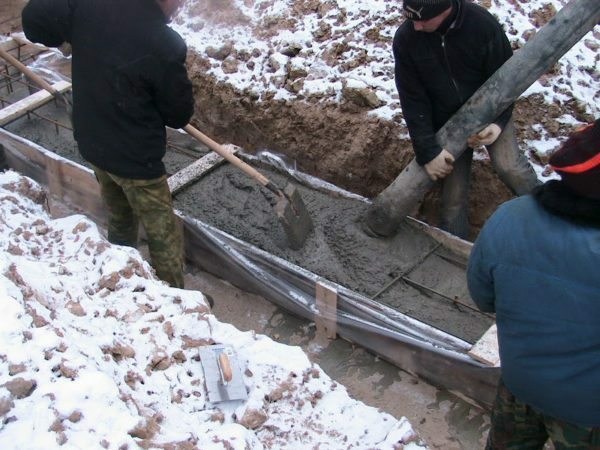
When adding antifreeze concrete can long remain mobile even in the bitter cold.
- hydrating additives - the same as curing accelerators, about which I wrote above.
- Purpose winter hydrating additives is set to provide a concrete strength of at least 50-70%, before all the water is transformed into ice;
- For this complex additive consisting of chlorides of sodium and calcium salts are most often used, sodium nitrite and organic components;
- Recommended additives hydrating use temperature - -25 to +10 ° C;
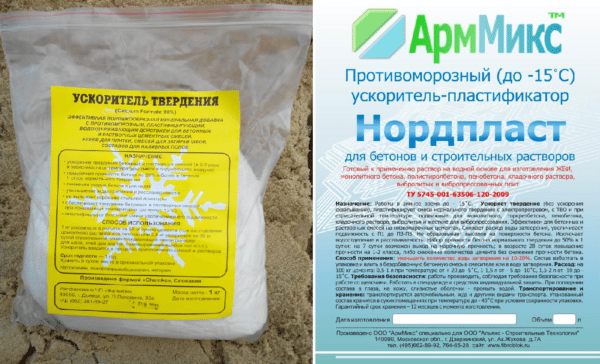
Detailed guidance on the use of additives specified on each original packaging.
With the use of salt additives need to be careful. If, during the preparation of the solution, you exceed the recommended dosage, the concrete mix can already grab for 10-20 minutes.
Air-entraining additives, and blowing
As the name suggests that these types of additives help saturate the concrete mix bubbles of air and gas. They are applied in the following cases:
- gas generating agent - mineral substances that react with the components of the solution, and allocate the bubbles of carbon dioxide:
- Used in the manufacture of light brands of cellular concrete, foam concrete and aerated concrete;
- Due to its low density and porous structure, such materials have a small specific gravity and exhibit good thermal and sound insulating properties;
- Foamed solution by the gas bubble increases in volume, which allows more economical use of expensive components for the production of concrete.
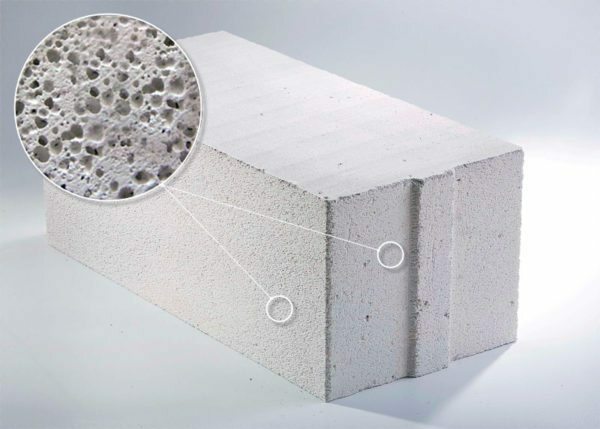
Aerated concrete blocks have a finely porous structure due to saturation of the gas bubbles.
- Air entraining agents - chemicals that facilitate gripping and retention of air bubbles during mixing of the solution in a concrete mixer:
- A plurality of air bubbles penetrate between the particles of coarse and fine aggregate and thereby provide natural lubrication;
- Due to the air bag decreases the friction force between the solid particles so obtained solution more mobile and pliable;
- Air bubbles do not come to the surface and remain in the cured concrete, forming a cavity damper;
- When the moisture freezes in the pores starts to increase in volume, it does not break the concrete, and expands in the pockets of the damper;
- Thus, air entrainment to protect concrete from cracking and allows to increase the number of freeze / thaw cycles.

Air-entraining additives can only be used at positive temperatures.
additives
Below I'll talk about chemicals, which in themselves do not affect the formation of cement stone, but at the same time make it possible to improve the performance properties of concrete:
- hydrophobic compounds can reduce the permeability of concrete to water molecules. They are made on the basis of polymeric, bituminous or silicate resins.
- Repellents are applied by pouring foundations, construction of swimming pools, cellars, septic tanks, caissons and other buried concrete structures;
- Liquid glass - the most common and inexpensive option. As concrete pour, waterglass particles crystallize and fill the pores in the concrete;
- Penetron - penetrating water repellent polymer-based. It can be used even after the concrete hardening. Synthetic resin by reacting with the cement polymerized, and tightly sealed all voids, pores and cracks.
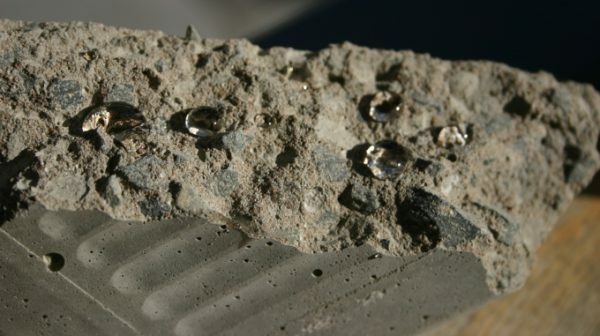
Concrete with high quality hydrophobic treatment is practically not wetted by water.
- anticorrosive additive used to protect the reinforcing steel from oxidation and corrosion:
- Made on the basis of alkalis or acids which have a weak reaction to iron;
- The reaction on the metal oxide film remains, which protects it from oxidation;
- Such drugs are used in the manufacture of concrete with the addition of salt solutions of plasticizers and anti-freeze.
- Modifiers and hardeners - generalizing the name of complex additives, which may include several components. For example, the drug "Polyplast" contains plasticizers, antifreeze components and ukoritel cement setting;
- biocidal additives They contain in their composition the antimicrobial and antiseptic preparations. They inhibit the growth and development of putrefactive bacteria, mold, moss, lichen and other harmful organisms.
- pigment dyes allow to paint concrete products in any suitable color. Used in the manufacture of paving slabs, building blocks, liquid concrete floors and small architectural forms.
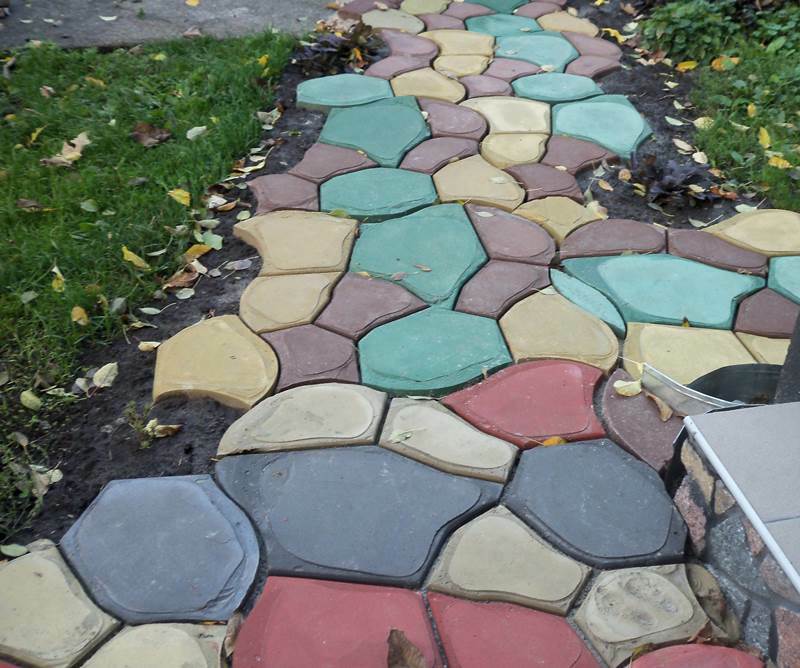
To make colored paving tiles, color pigments should be diluted in water and added to the mixer at the beginning of a solution.
When using pigment inks need to be borne in mind that the concrete itself has a gray color. Therefore, even with the addition of a large number of colors, you do not get to achieve bright and saturated colors.
Cost additives for concrete
All these chemicals are sold in a wide range in any building hypermarkets. Dry formulations usually packed in paper bags at 2.5 or 25 kg. Liquid reagents are filled into plastic bottles or canister volume from 1 to 10 liters.
Approximate prices:
- Cost and super- giperplastifikatorov and retarders and concrete curing accelerator is about the same, and is from 110 to 250 rubles per kilogram;
- Antifreeze salt additives are cheaper - from 80 to 150 $ / kg;.
- The average price of complex modifying additives can be from 200 to 400 rubles / kg.;
- The hydrophobic compositions are more expensive - from 280 to 500 rubles / kg.
- The most expensive are considered air-entraining components - from 300 to 650 rubles / kg.
- Coloring pigments, depending on their color may be from 160 to 350 rub. / Kg.
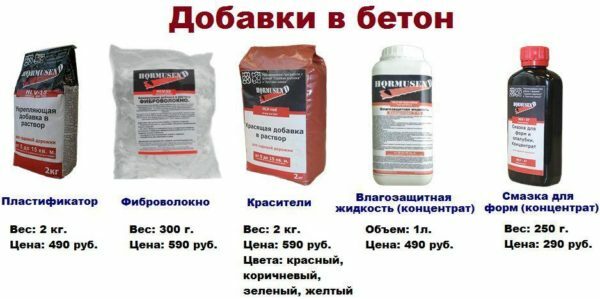
Here are the approximate prices, so in different places, they can vary greatly.
conclusion
Now that you know how to properly prepare a concrete solution, and in what cases it is necessary to use plasticizers, accelerators, retarders and other waterproofing additive to concrete. I recommend to watch the video in this article, and all your wishes and questions leave me in the comments.


